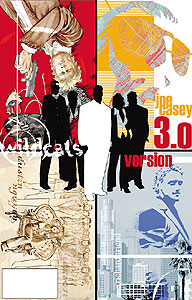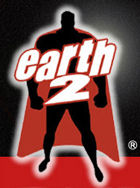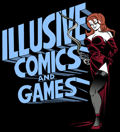| Wildcats
Version 3.0: Brand Building
It's odd
to look back at what Wildstorm Productions used to offer and
see just how much the company, the titles, and even the characters
have changed. The changes started around the time that Jim Lee
sold the company (or merged or whatever business term applies)
to DC. Wildstorm seemed to pick up momentum quickly, with books
like Stormwatch and The Authority (thanks both
to Warren Ellis, that loveable, dodgy Brit), and has been making
even more appearances on critics' top ten lists since its "Eye
of the Storm" adult-oriented imprint launched, bringing
books like Sleeper and Stormwatch: Team Achilles.
One of
Wildstorm's oldest books is Wildcats. It's a title with plenty
of history behind it. It's been through three major incarnations,
or versions as writer Joe Casey has come to calling them.
You probably remember the first: anatomically "gifted"
superheroes with delusions of X-Men trying to stop an alien
invasion from overtaking the Earth, and calling themselves
a "Covert Action Team." It was crap for the most
part, as was many-a-title back in the early days of Image
Comics. It was a pure art book, allowing Lee to sketch some
nifty pictures without worrying too much about story dynamics
or plot.
When Lee
started to reduce his presence in the comic creation business
and focused more on…well, actual business, the book eventually
got into the hands of Joe Casey. The superhero trappings of
the first series (which ended after 50 issues) were diminished
when Casey jumped onto the book, and Casey began to focus
more on the lives of the characters and how the end of the
inter-galactic war had affected them. Version 2.0 has been
noted as being the turning point for Wildcats, changing
the book into more than the previous "superheroes blow
things up" book it was.
Which
leads me inexorably to Version 3.0: Brand Building,
the first collection of the third series. Casey chose to change
the direction of the comic yet again, this time creating something
that is more akin to a book about corporate power brokering
and industrial espionage, as well as delving into the world
on information trading and plenty of action.
Jack Marlowe,
former android leader of the superhero team Wildcats and alien
consciousness, has inherited the Halo Corporation from his
"uncle" and team mentor Jacob Marlowe. What to do
with billions of dollars at your disposal? Vacation maybe?
Or you could take Jack's position and decide to corner the
consumer market with a product that revolutionizes every industry
in the world, making your company the single most powerful
and recognizable corporate entity on the planet.
See, Jack
has a larger plan to improve his adopted home-world, and spandex
is not required. Better living through consumerism is the
motto. But there are aspects of Halo's business that require
a less…dainty touch; enter Grifter, former Wildcat and
wetworks man for Halo Inc.
Jack is
keeping tabs on aspects of certain governments, making broad
purchases of industry and businesses, and some of these instances
make for some oddly funny moments in a usually somber and
cerebral book. For instance: does your multi-national conglomerate
need a new financial planning division? Why hire a slew of
employees who aren't contractually obligated, when you can
just buy the best accounting firm in the business and make
yourself their only client?
The cast
Casey introduces, while somewhat steeped in the twisted continuity
that has arisen from the evolution of Wildstorm as a company
(and of Wildcats as a comic book), doesn't detract
from the genius of the book. Casey even takes a page in the
front of the book to give a brief run-down of the characters
that will appear in the story, which is a small gesture that
more comic writers should make to help the younger fans who
aren't as aware of the continuity, or those of us that only
ever received a smattering of it during our formative comic
book years. The story is kept accessible and you never need
to have read previous story arcs to understand the plot.
The plot
itself is also rife with high points of interest that tickle
the old cerebellum, mixed very well with the action-oriented
scenes. Casey somehow makes a boardroom scene or a financial
meeting seem just as dramatic as a multi-corpse gunfight.
Part of that is due to Casey's use of characterization. Jack
Marlowe is a cold, logical, businessman that is cool in any
situation. His scenes are always ones where he is in control.
On the flipside, we see Casey characterize Grifter as more
human than his android companion, showing human frailty mixed
with the same cold dedication to his work that Jack has. The
scenes these two perform in play off of each other well, and
Casey often places the scenes back to back, demonstrating
the dichotomy. Casey gets to moralize with the character of
Mister Wax, bringing up some very interesting historical parallels
between Reconstruction Era America and the modern wariness
of corporate power in the U.S. And with the character C.C.
Rendozzo, who is not as yet part of the corporate team, Casey
makes a great foil that may or may not become an ally of Halo
Inc.
The artwork
is spectacular, but I tend to expect this from Wildstorm nowadays.
Dustin Nguyen and Richard Friend (penciler and inker respectively)
work well together, and Nguyen is under-praised for his realistic
and detailed drawing style. He's on par with Bryan Hitch and
his ilk when it comes to setting scenes that have a kinetic,
moving feel to them, and displaying action that is break-neck
and well choreographed. One scene, where Grifter is in a firefight
and Nguyen places the perspectives at odd angles (down-angle
shot of Grifter looking up at a gun-wielding adversary par
example) are memorable and show that someone can still surprise
me when putting a scene together. What's more, Nguyen and
Friend manage to add a quiet threat to even the silent scenes
and somber scenes, when Jack is talking to employees or when
Mister Wax is searching the Halo building for clues as to
what exactly Marlowe's goals are. There's menace in those
panels; promises that there's more to the story than you get
in this volume.
Also of
note are the various covers that are placed throughout the
book at issue breaks. Nguyen and Ryan Hughes make some interesting
visuals, crafting fake advertising for the Halo Brand, from
sunglasses to cologne. It fits the book perfectly serves as
a comment on the country's rampant consumerism. I also love
the coloring on this book: Randy Mayor and Larry Molinar do
damn good work, though I can sense a touch of digital coloring,
which some readers seem to loathe. We call those people "traditionalists,"
and as Warren Ellis might say, you can't get rid of them…no
matter how many condoms you sell.
It's a
damn good book and future volumes seem likely, so it's a sound
investment. Support your local capitalistic comic book endeavors
(i.e. comic shops) and go grab yourself a copy. And
don't be afraid of feeding the corporate machine. I'm sure
it has your best interests at heart...
Wildcats Version 3.0: Brand Building
|






